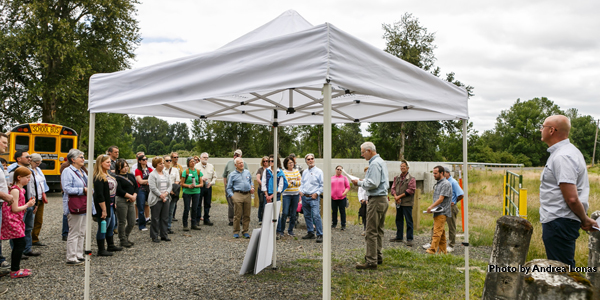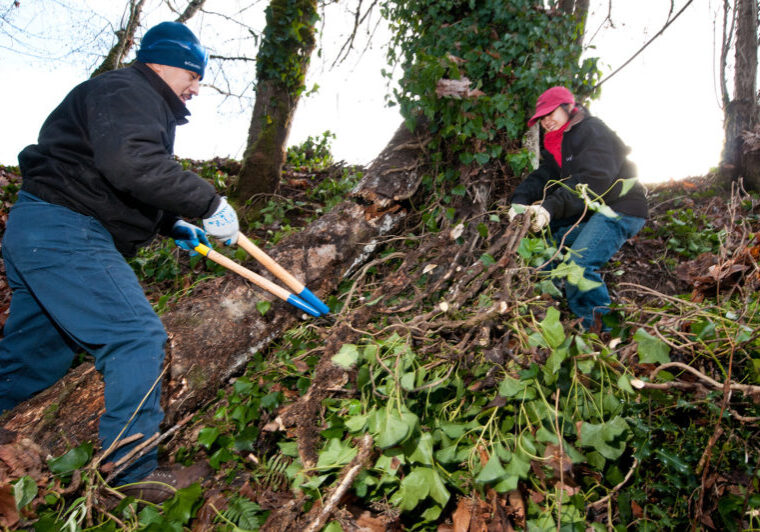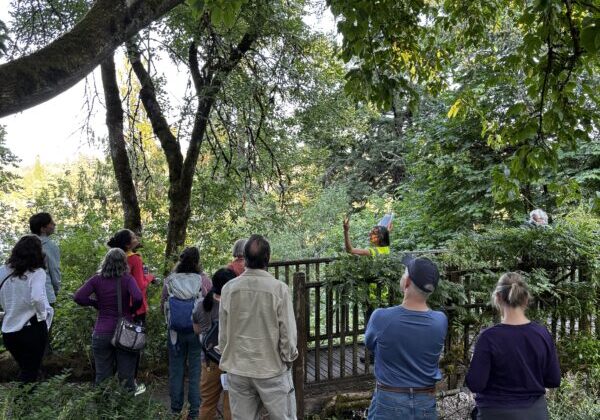In June, alongside many partners in the Sturgeon Lake Restoration Project, we celebrated the completion of the decades-long project to reconnect Sturgeon Lake to the Columbia River.
West Multnomah Soil & Water Conservation District and partners restored a stream system that allows natural flow from the Columbia River through Dairy Creek channel into the lake and out the Gilbert River. This hydrologic connection will increase water quality in the lake and wetland.
Past efforts to restore a direct hydrologic connection between Sturgeon Lake and the Columbia River were thwarted by a flood in 1996 that deposited sand and woody debris at the mouth of Dairy Creek and blocked the flow of water from the Columbia River. The solution was to replace two failed culverts under Reeder Road with a new bridge, remove the sand and debris plug from the mouth of Dairy Creek, and create a permanent channel for low flow and high flow water levels, planted with native trees, shrubs, and grasses.
At the celebration, we heard a heartfelt presentation from our Zone 4 Director, Brian Lightcap, who has been involved with the project from the beginning. We are pleased and honored to share a transcript of his presentation here.
Good afternoon. This a good day for West Multnomah SWCD, the public, salmon, sturgeon, waterfowl and lamprey.
I had to ask myself, “Why am I standing here?” Well, you will be spared from all the unsavory adventures of my efforts to restore the lake. But, I’ve an intimate connection with water adventures for 60 years. I came to Portland in 1970, married in 1971 and built 2 canvas kayaks with Alaska yellow cedar ribs in 1973. My late wife, Christine, and I explored rivers and lakes together.
Guilds Lake was long gone, and Smith and Bybee Lake lost 50% of its wetlands as I watched from my kayak and also in my official duties with the U.S. Army Corps of Engineers (USACE). I saw tidal influence snuffed out with a small dam to control botulism, which still occurs under the watchful eye of grass carp. The study I required of the U.S. Fish and Wildlife Service and contractor Paul Fishman, was to study existing fishery conditions, which revealed that during the Columbia River spring freshet, millions of juvenile salmon used these lakes for several weeks, then swam out. That turned out to be important new knowledge.
Vancouver Lake is a whole other can of worms as apparently the complex structure to allow water to flush the lake eventually had problems. That left only Sturgeon Lake which had been impacted by dikes built in the 30’s.
I was asked to be on the SWCD board in 1982. I was known because I was a farm cooperator and also apparently valued as I worked for the USACE and actually I got some funding and work done by the Corps and Port of Portland to add to the EPA Clean Lakes grant.
Today, we, especially thank Joe Lucas and Frank Newton (need to add affiliations here), who got much of the backing from many other financial contributors, enough to finalize studies, especially how the tidal and river flow could positively influence the lake by gradually flushing out sediments. There were many voices close to this project that advocated for dredging and even having gravel sales to pay for the work.
The project began with the U.S. Forest Service Spider (equipment) that removed logs debris. We got quite delayed when a 150-foot-long ship was found. It apparently was the foundation for a barn over Dairy Creek! The ship was built with Alaska yellow cedar. Project got completed and the rest is history. The creek began flushing the lake in ’93, and then the 96′ flood plugged it up again.
Mark Nebeker (of Oregon Department of Fish and Wildlife) and I worked our tails off seeking funding. Later our new District Manager, Dick Springer, put his shoulder to resurrecting forward progress, especially trying to find the right person at Bonneville Power Administration to work with. And, finding a dedicated lawyer, Fritz Paulus. Dick knew a lot of people. For years, it was tough sledding to get my conservation district colleagues to believe in this project that had a scary price tag.
I went to a salmon summit at Skamania Lodge around 2010 and learned not all the salmon pros were on the same page. They didn’t believe in the significance of “off channel” lakes in the downstream migration of salmon.
Well, at one time there were 4 major lakes: Smith & Bybee Lakes, Vancouver Lake, Guild’s Lake, and Sturgeon Lake. Guild’s is history, partially filled with sediment from hydraulic blasting of the hillside, Smith & Bybee was blocked by improvements to North Portland Road after the Vanport flood, and Vancouver Lake was dredged for recreation with minimal consideration of salmon use. It now has a serious toxic, algal bloom issue.
But, today, I’m proud of the dedication of our many partner agencies, organizations, and private donors who were determined to believe that Sturgeon Lake, the fourth lake would be the one lake left standing, in spite of all the doubt from fishery and hydrology professionals. We all saw this through and will stand together as the destiny of Sturgeon Lake unfolds.



